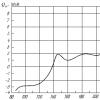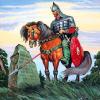Animal behavior and psyche, relationships and characteristics. Comparison of the psyche of animals and humans. Comparison of the psyche of animals and humans
Sensitivity.
Instinctive behavior.
Skills.
Intellectual behavior of animals.
The behavior of animals and humans is determined by the level of mental development. All forms of behavior are divided into congenital And acquired during life.
Congenital forms provide a biologically appropriate response to certain environmental conditions. Every living creature - both animals and humans - has such forms of behavior.
4.1. Sensitivity
The first signs of the psyche in the animal world appear in lower animals and manifest themselves in the form sensitivity. The physiological basis of sensitivity is irritability- the ability of living organisms to respond to biologically significant (vital) influences and stimuli. When living organisms begin to perceive environmental influences that themselves do not have a direct biological meaning, but can signal about biologically significant stimuli, sensitivity occurs.
A change in the shape of a plant, which seems to move towards the light (tropism), is not a manifestation of sensitivity, since this is a direct reaction to a biologically significant (significant for its preservation) stimulus. The movement of a toad capturing a flying 76 is a completely different matter.
a simple moth. The movement of the moth, its shape, the light reflected by its wings cannot in themselves satisfy the immediate biological need of the toad for food. But they signal it. The perception of such a signal is sensitivity. In the process of evolution of living organisms, sensitivity arises very early.
Lower animals react only to individual properties of the surrounding world. This stage of mental development characterizes elementary sensitivity. But such sensitivity provides only undifferentiated sensations. At this stage, behavior is almost entirely determined by instincts.
4.2. Instinctive behavior
Instincts- congenital, hereditarily fixed acts of behavior aimed at satisfying biological needs. Instinctive behavior manifests itself at all levels of the evolutionary ladder - from lower animals, insects to humans. At all stages, the basic instincts are the instincts of self-preservation, food and sexual instincts. But the higher a living creature is on the rung of this ladder, the less role instinctive behavior plays in its daily life.
The main mechanism for the implementation of such behavior is unconditioned reflexes.
Instinctive behavior is very important because it provides survival opportunities from the very first moments. ments of life before acquiring your own experience. However, in changing conditions, such behavior cannot satisfy the necessary needs and becomes inadequate.
Let's give an example. A very important innate instinct of goslings is the instinct to follow. The newly born gosling is ready to follow the first moving object that comes into its field of vision. Under normal conditions, this is biologically expedient - he follows the mother goose and thanks to this he receives everything he needs for life. Animal behavior researchers have repeatedly conducted experiments in which the first moving object that came into the caterpillar's field of vision was a person or a rolling ball or a wind-up toy. The gosling began to follow her. Even when he was offered a choice -
Whether to follow the object he saw first in his life or the real mother duck, he chose the former. It is clear that such behavior is biologically impractical, but contrary to this, insects, animals, birds repeat them without changing.
Bee honeycombs have the greatest capacity with a minimum area. The impression is that this is an example of the finest mathematical calculation. The bee's instinct forces them to build honeycombs in a way that is biologically expedient. Instinct forces the bee to diligently seal the cells of the honeycomb in order to preserve honey in them. But if you pierce the bottom of the honeycomb, the bee will also clog it, although there is no point in this anymore: honey will flow out of such honeycombs.
Thus, instinctive behavior is appropriate in stereotypical conditions and inappropriate in a constantly changing environment.
Therefore, they are of particular importance for the life of living beings. acquired forms of behavior.
The content of the article
ANIMAL PSYCHOLOGY(comparative psychology, animal psychology), a branch of psychology that studies the psyche of animals. Research in this area, conducted both in laboratory and in natural conditions, is aimed at studying the psychological factors influencing the functioning of animals, as well as various aspects of similarities and differences in their behavior. Animal psychologists pose the following main questions: what is the influence of heredity and environment on the psyche and behavior; what is the role of instincts in animal behavior; to what extent behavior is determined by learning; how behavior changes during the individual development of an animal; what is the adaptive function of the animal’s psyche in its natural environment.
From a historical and scientific perspective, psychology was considered as a field of knowledge that exists separately from ethology - the science of animal behavior in their natural habitat. The first ethologists were European scientists who mainly used the method of observing animals in natural conditions. Animal psychology was developed in US university laboratories, where experimental studies were carried out.
Ethologists are usually zoologists interested in the development and adaptive significance of behavior, as well as its hereditary and evolutionary background. Animal psychologists, as a rule, receive psychological education, and in the behavior of animals they are interested in psychological processes, namely learning, motivation, memory and perception; in addition, they try to determine the neuropsychological mechanisms of a particular form of behavior.
Nevertheless, ethology had a great influence on animal psychology and contributed to expanding the scope of its research. Animal psychologists are now actively studying such problems as the role of heredity in behavior and the adaptive significance of instinctive and acquired forms of behavior. Currently, animal psychology and ethology are moving closer and complement each other in an attempt to understand animal behavior in all its complexity.
HISTORICAL ASPECT
Man began to think about the behavior of animals in ancient times. Heraclitus assumed that people and gods have reason and soul, while beasts (animals) are unreasonable and have no soul. In contrast, Aristotle, in the course of his discussions of the evolution of animals and their classification, formulated some of the first principles of animal psychology.
The first book in the field of animal psychology was Comparative psychology(Psychology comparison, 1864) P. Flourens. However, the main impetus for the development of modern comparative psychology was given by the famous work of Charles Darwin Origin of species (Origin of Species, 1859), containing a discussion of the adaptive role of instincts and behavior in different animals. His ideas prompted many scientists - philosophers, naturalists and biologists - to develop those areas of research on the basis of which zoopsychology and ethology as sciences were subsequently formed. Darwin's later work Expression of emotions in humans and animals (Expression of the Emotions in Man and Animals, 1872) also played a huge role in the development of a comparative approach to the study of animal behavior.
At the end of the 19th century. A number of books on animal psychology have been published. One of the most famous Animal mind(Animal Intelligence, 1882), was written by biologist J. Romanes. J. Loeb's theory of tropisms, proposed in 1890, explained behavior as movement towards or away from a stimulus due to physicochemical reasons ( see also LOEB, JAK). After the publication of W. James's book Principles of Psychology (Principles of Psychology, 1890) and the dissertation of E. Thorndike Animal mind: experimental study of associative processes (Animal Intelligence: An Experimental Study of the Associate Processes of Animals, 1898) animal psychology became a systematic scientific discipline.
In the first half of the 20th century. animal psychology was heavily influenced by theorists who argued that the environment and learning played a decisive role in shaping behavior, and often did not take into account the biological factors on which perception and learning itself depend. Many animal psychologists became followers of K. Hull, E. Tolman, E. Gazri, B. Skinner. Only a few researchers (R. Yerkes, K. Lashley, N. Mayer and T. Schneirla) remained within the framework of a broader, physiologically oriented approach.
MAIN AREAS OF RESEARCH
Evolutionary adaptation.
Researchers of animal behavior were greatly influenced by Darwin's ideas that during evolution, animals were selected on the principle of best adaptation to environmental conditions. Only when animal behavior is examined from the perspective of evolutionary theory is it possible to identify fundamental principles that apply to large groups of animals. For example, one study compared the behavior of carnivorous mammals, such as lions and bears, and ungulates, such as antelope. Carnivores are predators and are not usually prey for others. On the contrary, ungulates are constantly hunted, but they themselves do not kill other animals, except in some exceptional circumstances. The types of behavior of these two groups are completely different. Ungulates are herd animals; predators do not gather in herds, although some, in particular lions and wolves, unite in small groups. Mating of ungulates occurs faster, they sleep little and lightly and drink very quickly when given the opportunity. Carnivores, on the other hand, take a long time to mate, sleep soundly, and take their time when drinking. Childbirth in ungulates proceeds quickly, they do not prepare a special place for this, while carnivores prepare a hole or lair, and childbirth takes a long time. These differences in behavior clearly correspond to what is necessary for the survival of each group, and apparently arose under the pressure of natural selection.
Genetics and behavior.
The behavior of animals depends primarily on their anatomy and neurophysiology. However, the focus of their attention and ability to learn is also determined by hereditary predisposition, and, accordingly, by the genetic characteristics of the species. For example, primates are particularly sensitive to the calls of members of their own species and are likely genetically predisposed to recognize the meaning of these various sounds. Frogs have a special property of the visual system that allows them to notice flying insects that they can grab and eat. At the same time, they do not react to immobilized insects, and even if they are placed around the frog in large quantities, it will die of hunger, but will not touch them. Many animals have good depth perception from birth. Barely hatched chicks in nests on rocks avoid approaching the edge of a cliff, while ducklings do not show such caution.
Environmental influence.
Studies of primates in natural environments have shown that threat from predators and food availability can lead to significant changes in social organization, even among closely related species. One study compared the social organization of two species of baboons, anubis and hamadryas; both live in Ethiopia, but in different ecological niches. Anubis have more access to food because they live in or near forests and there are sources of water there. Hamadryas, on the other hand, live in arid areas where food is difficult to obtain. Both are hunted by large cats - lions and leopards. At the same time, Anubis live in large groups consisting of cubs and several adult males and females. Among hamadryas, the basic unit of the community is the harem, with one adult male and several females with cubs.
The hamadryas community is uniquely adapted to habitats where food is difficult to obtain and is only sufficient for the survival of a small group. One adult male provides both reproduction and protection, and the absence of other males reduces the overall food requirement. At night, several harems gather together and, in order to protect themselves from predators, settle down for the night under the protection of the few steep cliffs in this area.
The mechanism providing this social structure is partly determined genetically. The male hamadryas collects females and keeps them with him, regardless of whether they are in estrus - a state of increased sexual arousal and reproductive ability - or outside this period. In other words, male hamadryas are attracted to females simply because of their gender. The Anubis male, on the contrary, is not inclined to keep females with him, and they attract him only during the period of heat.
Social behavior.
All animals must interact with each other from time to time, at least to the extent necessary for mating and reproduction. Beyond these minimal contacts, the social relationships of animals vary from a predominantly solitary lifestyle to complete dependence on the group. The formation of communities in animals provides individuals or a group as a whole with certain adaptive advantages associated with factors such as joint protection from predators, joint acquisition of food, increased ability to withstand interspecific competition, and increased reproductive efficiency.
The genetic basis of sociality can be preserved in cases where it ceases to be necessary or even simply useful for the survival of the animal. For example, J. Scott, conducting a detailed comparative study of wolves and various breeds of domestic dogs, found that although domestic dogs had been genetically isolated from their wild ancestors (wolves) for 12,000 years, the behavior of both species remained largely similar. Social behavior is more pronounced in wolves, but in its main features it does not differ from the corresponding behavior of dogs. Both are herd animals. Both wolves and dogs communicate their location and condition by barking and howling. Both guard their territory and tend to bury food.
Like many other animals, dogs and wolves have critical periods in the development of social behavior when they are capable of forming the basic relationships characteristic of adults of the species. If a dog (or wolf) puppy has not established a friendly, trusting relationship with a person during the first 14 weeks of life, the animal will remain “wild”, will avoid and be afraid of the person.
Communication.
The most powerful means of communication is language, which is unique to humans. All animals exchange information, but not all information exchange occurs through language. Language is an open communication system that allows you to introduce and use new units (words) in new combinations, and thereby constantly expand the semantic side of messages, to which those who receive them react accordingly.
Research by B. Gardner, A. Gardner, D. Primack, D. Rumbaugh and E. Savage showed that by using a “non-vocal” language system and long-term training, chimpanzees can develop complex, linguistically significant communication skills. These skills include the ability to learn the meaning of new “words,” respond to words, apply them correctly, name things based on their most salient features, and even “talk.”
Behavior and learning in primates.
The behavior of great apes is currently being intensively studied both in natural and laboratory conditions. Because these apes are in the closest evolutionary relationship to humans (also a primate), studying them provides a unique opportunity to find answers to a number of questions important to our own species: What behavioral traits are common to all primates? The pressure of what evolutionary factors can explain the similarities and differences in the behavior of existing primate species? How do environmental factors acting in the early period of individual development influence the acquisition of normal social and cognitive skills? What methods of communication do primates use, and what types of information are they able to exchange?
Studies of primates in natural environments focus on their social structures, diet, parental behavior, predation (and defense against it), use of the natural environment, kinship, and various aspects of social interaction. In laboratory conditions, perception and learning, communication, physiology and endocrinology are studied, which are difficult to study in natural conditions.
Comparing the psyche of animals with the human allows us to highlight the following main differences between them.
1. An animal can act only within the framework of a situation that is directly perceived, and all the acts it performs are limited by biological needs, that is, motivation is always biological.
Animals don't do anything that doesn't serve their biological needs. The concrete, practical thinking of animals makes them dependent on the immediate situation. Only in the process of orienting manipulation is the animal able to solve problematic problems. A person, thanks to abstract, logical thinking, can foresee events and act according to cognitive necessity - consciously.
Thinking is closely related to broadcasting. Animals only give signals to their relatives about their own emotional states, while humans use language to inform others in time and space, conveying social experience. Thanks to language, every person uses experience that humanity has developed over thousands of years and which it has never directly perceived.
2. Animals are capable of using objects as tools, but not a single animal can create tools. Animals do not live in a world of permanent things and do not perform collective actions. Even watching the actions of another animal, they will never help each other or act together.
Only man creates tools according to a well-thought-out plan, uses them for their intended purpose and saves them for the future. She lives in a world of permanent things, uses tools together with other people, takes on the experience of using tools and passes it on to others.
3. The difference between the psyche of animals and humans lies in feelings. Animals are also capable of experiencing positive or negative emotions, but only a person can sympathize with another person in grief or joy, enjoy pictures of nature, and experience intellectual feelings.
4. The conditions for the development of the psyche of animals and humans is the fourth difference. The development of the psyche in the animal world is subject to biological laws, and the development of the human psyche is determined by socio-historical conditions.
Both humans and animals are characterized by instinctive reactions to stimuli and the ability to gain experience in life situations. However, only a person is capable of appropriating social experience, which develops the psyche.
39. Definition of Consciousness
Consciousness is the highest, human-specific form of generalized reflection of the objective stable properties and patterns of the surrounding world, the formation of a person’s internal model of the external world, as a result of which knowledge and transformation of the surrounding reality is achieved. The function of consciousness is to formulate the goals of activity, to preliminary mentally construct actions and anticipate their results, which ensures reasonable regulation of human behavior and activity. A person’s consciousness includes a certain attitude towards the environment, towards other people: “My attitude towards my environment is my consciousness” (Marx). The following properties of consciousness are distinguished: building relationships, cognition and experience. This directly follows the inclusion of thinking and emotions in the processes of consciousness. Indeed, the main function of thinking is to identify objective relationships between phenomena of the external world, and the main function of emotion is to form a person’s subjective attitude towards objects, phenomena, and people. These forms and types of relationships are synthesized in the structures of consciousness, and they determine both the organization of behavior and the deep processes of self-esteem and self-awareness. Really existing in a single stream of consciousness, an image and a thought can, colored by emotions, become an experience. “Awareness of an experience is always the establishment of its objective relation to the reasons that cause it, to the objects to which it is directed, to the actions by which it can be realized” (S. L. Rubinstein). Consciousness develops in humans only through social contacts. In phylogenesis, human consciousness developed, and it becomes possible only under conditions of active influence on nature, in conditions of labor activity. Consciousness is possible only in the conditions of the existence of language, speech, which arises simultaneously with consciousness in the process of labor.
The development of the psyche in phylogenesis led to the emergence of its highest form - the human consciousness.
As A.V. Petrovsky notes, consciousness has a number of specific characteristics:
- consciousness is a system of knowledge about the world in concepts (expresses the internal, deep connections of phenomena, their causes and essence);
- the structure of consciousness includes all cognitive mental processes;
- consciousness is connected with language and speech, and manifests itself in them;
- consciousness is socio-historical in nature. Consciousness is not innate, it is formed under the condition of a person’s life in society (Mowgli children do not have consciousness);
- Consciousness is a level of mental development at which its owner is able to distinguish himself from the surrounding world (division into “I” and “not I”), i.e. in consciousness the difference between subject and objects is clearly separated;
- consciousness presupposes that the subject has the ability for purposeful activity, it ensures goal setting, choice of means to achieve results, control and adjustment of actions, planning and forecasting;
- consciousness includes a certain system of relationships of a person to the surrounding reality and to himself (the world of feelings).
The existing nature of the differences between the psyche of animals and human consciousness can be reduced to the following (see table 1)
Table 1
Comparison of animal psyche and human consciousness
| Animal psyche | Human consciousness |
| Animals obey biological laws. Their activity is directly biological, related to the satisfaction of biological needs. At the same time, the activity of animals is individual in nature. | Man lives according to social laws. His activity is connected not only with biological needs, on the contrary, sometimes it even comes into conflict with them (heroism). Human activity is collective in nature; a person has a division of labor, during which participants perform various operations that in themselves appear meaningless. |
| Activity at the level of adaptation to the environment | Activity in the form of activity associated not only with adaptation, but also with the transformation of reality. |
| Conditions for the development of the psyche: - collective innate experience (inherited instincts); | - individual experience acquired in the course of life. |
| Conditions for the development of the psyche: - collective innate experience; | - individual lifetime experience; |
| - social experience (cultural inheritance - appropriation of the experience of previous generations through communication and learning). | Animals have access to basic emotions. |
| Along with emotions, a person develops higher feelings (friendship, love, a sense of duty, a sense of humor, criticism and self-criticism, etc.) | Orientation and actions within the I signal system |
| In general, the behavior of animals is determined by the current situation and immediate impressions, while animals do not give an account of their actions and impressions. | It is typical for a person to abstract from the immediate situation and impressions. He has advanced reflection, forecast and control, figurative and abstract-logical thinking, imagination. A person is able to give an account of his actions, feelings, and actions. |
All these properties allow a person to more freely regulate his behavior (understand the world around him and himself, pass on to the next generations not only individual experience, but also the experience of past generations, social experience). The source of consciousness is the external world, it is active and directed at the objective world and oneself, connected with internal conditions (“External influences are refracted through internal conditions” - S. L. Rubinstein). Consciousness is a topic that still interests researchers, but psychologists have discovered many amazing phenomena of consciousness.
In the process of the emergence of human consciousness, domestic psychologists (A.N. Leontiev, A.V. Petrovsky) assign a special role to work and language.
A person is not aware of all mental processes and states, that is, he is not aware of his actions, actions, and thoughts. This unconscious processes.
Unconscious 1) a set of mental processes, acts and states caused by phenomena of reality, the influence of which the subject is not aware of; 2) a form of mental reflection in which the image of reality and the subject’s attitude towards it do not act as an object of special reflection, constituting an undifferentiated whole.
Three classes of unconscious processes can be distinguished:
1) supraconscious processes. In the process of conscious work (solving problems), unconscious work of thought can occur along the way. At a certain moment, this unconscious work is included in the conscious process, and a sudden intuitive solution arises - insight. A solution has been found, but a person cannot explain how this happened. Only a speech report will allow you to understand the decision. Similarly, memories can occur, images of the imagination arise, etc.;
2) unconscious drivers of activity (unconscious motives and attitudes). The role of attitude (the body’s readiness to perform certain actions) was studied by D.N. Uznadze. In the process of life, a person develops an unconscious readiness, for example, to take small objects with three fingers, to perceive a large object as heavier, etc. There may also be social attitudes: the effect of false consent (everyone says so), the tendency to positively evaluate friends, etc. 3. Freud tried to explain this form of the unconscious, understanding by the unconscious unrealized drives that, due to a conflict with the requirements of social norms, were not allowed into consciousness , alienated themselves through the mechanism of repression, revealing themselves in slips of the tongue, slips of the tongue, dreams, etc.
3) unconscious regulators of activity performance (automatisms - walking, abilities, skills, habits, methods of action (for example, solving problems, etc.).
Thus, the unconscious helps a person to feel identity with himself, takes control of behavior when consciousness has coped with difficulties and a decision has been made. The unconscious is a specifically human phenomenon and is not a lower level of the psyche. It is determined by the social conditions of consciousness and is connected with it.
Materials used for the lecture, additional literature on the topic:
1. Gamezo M.B., Gerasimova V.S., Mashurtseva D.A., Orlova L.M. General psychology: Educational manual / Ed. ed. M.V. Gamezo. - M.: Os-89, 2007. - 352 p. (Section 1. Introduction to general psychology Topic 2. Development of the psyche in phylogenesis)
3. Semenova L.E. General psychology. Lecture course. Nizhny Novgorod.
Phylogenesis(Greek phyle - tribe, genus, species; genesis - origin, history of the genus) - the origin and, in a broader sense, the evolution of species or other forms of animals or plants; evolutionary history.
Ontogenesis(Greek ontos - existing; genesis - occurring, birth) - the origin and development of an individual organism, the biological development of the organism from the moment of birth to the end of life.
Irritability– the property of a living organism to respond to biologically significant (biotic) influences, both beneficial and harmful, but not neutral.
Sensitivity– the property of responding not only to biologically significant influences, but also to neutral (abiotic) ones
Consciousness is the key and most ambiguous term in psychology and many other sciences. Consciousness is the most confusing word in the dictionary. As a theoretical term, consciousness is the highest level of mental development and self-regulation, inherent only to humans.
- it turned out that the brain perceives and stores information that comes in such large quantities, or with such enormous speed, or with such low intensity that a person is almost unaware of any of it;
- it has been discovered that the brain almost instantly carries out computational, logical and semantic transformations of information of such complexity that a person is generally not able to perform consciously;
- Apparently, there is a special mechanism that makes decisions about what information from the information perceived and processed by the brain should be understood and what not. This mechanism tends to repeat both its decisions to be aware of something and its decisions not to be aware of it;
- it is shown that any random phenomenon is recognized as natural, consciousness attributes some causes to it;
- consciousness cannot help but control the results of its activities. As soon as a person is given the task of not being aware of any information, consciousness immediately begins to check whether it successfully solves the problem of ignoring and thereby automatically pays attention to what should be ignored;
- consciousness is inextricably linked with activity, since it controls it;
- If consciousness is faced with a discrepancy between its own constructions and reality, then it defends first of all its own guesses. Therefore, the consciousness spends more time working with unexpected stimuli, and the expected ones quickly cease to be realized. Information with which nothing needs to be done, but only remembered, is forgotten despite the conscious desire to retain it;
- consciousness does not so much reflect the external world as construct it - that is why its world is called subjective;
- the focus of consciousness on constructing guesses about how the world works (which may be erroneous) allows one to go beyond the very limited information about reality that a person receives from the senses and create ideas about what there is no direct data about: space and microcosm, about good and evil, about one’s “I” or about the consciousness of other people.
Information and irritability. The interaction of various material systems results in mutual reflection, which appears in the form of mechanical deformation, restructuring, decomposition of atoms, electromagnetic forces, chemical changes, physiological processes, psyche and consciousness. Reflection represents the result of interaction in which what belongs to the reflected body is fixed. Any change in one object as a result of its interaction with another has something in common, commensurate with the original object. It represents an isomorphic, i.e. structurally similar, reflection of any aspect of the object. Thus, some fossils clearly preserve the imprints of ancient fish and plants .
Isomorphic mappings are widespread in nature: the imprint in any object, obtained as a result of the interaction of the latter with another object, is isomorphic in its structure to some aspect of the other object. For example, the substructure of an animal's paw print on sand or snow is isomorphic to the part of the paw that participated in the interaction with sand or snow. Any reflection is information. It acts as a measure of heterogeneity in energy distribution. Any heterogeneity carries with it information. The concept of information is not associated with its meaningfulness. But it can also be meaningful. Information is information about something, a reflection of one object or process in another. For example, information is conveyed by speech, writing, sunlight, folds of a mountain range, the sound of a waterfall, the rustling of leaves, the appearance of a predator for a small animal, as well as a poster informing a person about a meeting or a movie, the flash of a light bulb in the input photocell device of an automatically adjusting machine and etc. The material means by which information is transmitted is a signal.
In humans and animals, direct sensory signals - sensations and perceptions - constitute the so-called first signaling system of reality. A person has developed speech, i.e. the second signaling system of reality which represents, in the words of I.P. Pavlova, “signals of the first signals.”
One of the important aspects of the interaction of any living organisms with the external environment is their extraction of information about the environment. The exchange of information between animals is expressed in the characteristic sound signals of animals and birds, warning of danger, and signal dances of bees. The most complex life processes occurring in plants are also consistent with environmental changes. In this adaptation to changes in conditions, a significant role is played, first of all, by the ability of plants to capture, reflect ongoing changes, and receive information about them. The ability to obtain and use information about the surrounding world is so important for life in general that it should be considered one of the fundamental properties of living matter.
In inanimate nature there is no need to use interaction products as special models of things. The need for functional replacement arises in living nature. Animals develop a special adaptive activity—behavior.
One of the properties of living things is irritability. Life arises where organic compounds appear that are capable of self-regulation, self-reproduction, self-preservation, reproduction, self-improvement through evolution and irritability. Irritability is a property of an organism’s life that consists in reflecting the influences of the external and internal environment in the form of excitation and external selective response.
In the process of evolution, the simplest forms of irritability, characteristic of lower species of living organisms, starting with single-celled organisms (for example, amoeba), plants, animals with a low-organized nervous apparatus (tropisms, taxis), are replaced by highly organized forms of behavior. Irritability is a prepsychic form of reflection; This is a property of the body that manifests itself in the form of only a physiological reaction, not yet associated with the emergence of a subjective image of the objective world. Irritability is a means of controlling and regulating adaptive behavior.
Sensitivity, psyche. The further stage in the development of forms of reflection is associated with the emergence of such a new property in higher forms of living matter as sensitivity - the ability to have sensations that reflect the properties of objects affecting the body. Sensations constitute the initial form of the animal psyche. Thus, psyche is not a property of living matter in general. It is a property of higher forms of organic matter. It is possible that the rudiments of sensations arose in animals that did not have a nervous system. There is no doubt, however, that, starting with the coelenterates, the psyche becomes a function of the nervous system and its further development is associated with the development of the nervous system. In vertebrates, the brain becomes the direct carrier of the psyche.
One of the characteristic features of animal organisms is activity, which is revealed in their object-oriented behavior. The latter is carried out through the organs of information created by evolution about surrounding things and processes, as well as the control and management of behavior in accordance with the information received. The body does not simply react to a situation, but is faced with a dynamically changing situation, which confronts it with the need for a probabilistic forecast and active choice. The body all the time seems to be playing a game with the environment: the rules of this game are not clearly defined, and the moves “conceived” by the enemy are known only with a certain degree of probability.
About instinct. To understand what the biological prerequisites of consciousness are, it is necessary from the very beginning to clearly distinguish between two types of animal action: instinctive, innate actions, and actions based on experience acquired during the individual development of each animal. The main instincts are nutrition (food), self-preservation (defensive), reproduction (sexual, parental), orientation, communication (gregarious, gregarious). A chicken, just hatched from an egg, begins to peck grain without any training, and a newly born calf begins to suck the udder of a cow. Animals have a vigilant instinct of self-preservation, which gives them a warning in time. Instincts can be very complex and... at first glance they give the impression of exceptional intelligence. Thus, beavers gnaw tree trunks, cut them down, clear them of branches, chew them into pieces and float them across the water. From sand or small branches they build complex “multi-chamber” dwellings with underwater and above-water exits on the river bank. To keep water at the same level, beavers build dams.
The instinct acts unerringly only under constant conditions. As soon as the conditions change, its unconscious character immediately appears. Bees skillfully make honeycombs that are perfect in shape and strength. But cut off the bottom of the cell - and the bee will not pay attention to it and will continue to fill the cell with honey.
The instinctive behavior of animals is the result of centuries-old adaptation of a given animal species to certain conditions of their existence. Thanks to this kind of adaptation of animals to a certain environment, they have developed an appropriate nervous apparatus, the nature of which is inherited. It is curious that, while predetermining the form of behavior, the innate mechanisms in a significant part of animals do not determine the object of this behavior: newly hatched chicks equally peck both millet grains and sawdust. The character of an object is given by experience. Instinct is a chain unconditioned reflex, i.e. a series of successive reflex movements, of which each previous one is the initial push for each subsequent one.
Elementary thinking in animals. Now let's look at another type of animal behavior. Migratory birds navigate their long journey by the sun during the day and by the stars at night. This is facilitated by the experience accumulated and passed on by tens and hundreds of thousands of bird generations. Both in natural conditions and in experimental conditions, animals practically not only perceive the properties and relationships of things in a rather differentiated manner, but also reflect a considerable number of biologically significant connections in the world around them, learn from their experience and use this experience in life. And this is elementary thinking.
Animal thinking reaches its highest level, for example, in apes and dolphins. The results of the experiments showed that the chimpanzee is also capable of changing the shape of an object that is completely unsuitable for direct use as a tool and requires processing by deforming plastic objects (wire), separating protruding parts of objects (branches), isolating parts from whole objects by splitting them (boards) ). The multilateral practical analysis carried out by chimpanzees when they differentiate the properties of entire objects, and sometimes of different parts of the same object, is closely related to practical synthesis. The latter is carried out when the monkey uses the properties of objects in the process of nest-building and when establishing connections between objects in cases of solving experimental problems that require the use of tools.
The chimpanzee has generalized ideas that determine its activity, which is especially clearly visible in the fact that the monkey isolates a tool from a whole object, for example, a splinter from a board. This kind of processing of material is noteworthy in that the chimpanzee isolates the part suitable for use, based not on the specific perception of a present object, partially or wholly suitable for use, but using a generalized visual image of a suitable tool or a concept developed during past experiences. Thus, the analysis of the situation from the sphere of practical action moves to the sphere of mental action and is implemented on the basis of a well-known generalization of the essential properties of a suitable tool. The high level of intelligence of chimpanzees is found not only in the recognition of surrounding objects that have the desired properties and their subsequent use, but also mainly in their modification.
The nature of the activity of the intellect of monkeys is explained by the biological conditions of their existence. A chimpanzee cannot mentally operate with ideas or imagine the future relationship of the parts of a composite tool. The activity of chimpanzees is based on reflecting the simplest vital connections of things.
Do animals think? Yes, they do. But not like people. The animal is not aware of its actions or its place in the world and among its own kind. The animal has neither consciousness, nor even self-awareness. Monkeys can sometimes use various objects to obtain food, for example, breaking a nut with a stone or reaching for a fruit with a stick. But these objects in the hands of a monkey are not real tools, and working with them is not real work. Not a single monkey invented a single tool



















